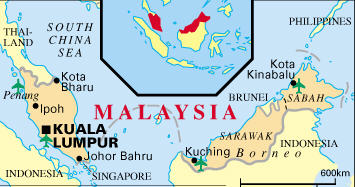
Malay (Bahasa Melayu)
Malay, also known as Bahasa Melayu, is a member of the Malayo-Polynesian branch of the Austronesian language family. It is spoken by the native Malay people on both sides of the Straits of Malacca that separate Sumatra from the Malay Peninsula. Since the Malacca Straits have always been a busy sea route, travelers came into contact with the language of the Malay people and spread it throughout the Indonesian islands. As a result, Malay became the lingua franca of the Indonesian archipelago, and eventually the main reason why it was chosen as the national language of the Indonesian Republic in the 20th century.

Status
Standard Malay is the official language of Malaysia and one of the four official languages of Singapore (along with English, Mandarin, and Tamil). It is also spoken in Indonesia, and Brunei, and is used as a working language in East Timor. It is spoken by 10.5 million people in Malaysia (2004 census) with a population total for all countries: of 15.8 million speakers of Malay as a first language with an additional 3 million second-language speakers (Ethnologue).
- Malaysia
In Malaysia, the language is known as Bahasa Melayu or Bahasa Malaysia. Since 1968, Standard Malay is the official language of Malaysia. However, the language of wider communication is colloquial Malay (Ethnologue). As a vestige of colonization, English is still considered a prestige language among the educated classes. It continues to be used in the majority of institutions of higher education. However, Malay is officially the medium of scientific, administrative, legal and other official matters. - Brunei
Malay and English are the two co-official languages of Brunei. Malay is spoken by over half of the population. English is widely used, especially by the Chinese and Indian minorities, because of its importance as the language of international business. - Singapore
In Singapore, Malay was historically the lingua franca among people who spoke different languages, but it has been replaced by English. Today, it retains the status of a national language. 15% of Singapore’s population speak Malay. - Indonesia
Known as called Bahasa Indonesia, it is spoken by 23 million people as a first language and by 140 million people as a second language. It has become the lingua franca for its numerous ethnic groups who speak a wide variety of languages. In East Timor (a province of Indonesia from 1976 to 1999), Bahasa Indonesia is widely spoken, and recognized by its Constitution as a working language.
Dialects
Regional variation
- The northern dialect, referred to as Malay, is spoken in Malaysia, Singapore and Brunei.
- The southern dialect is spoken in Indonesia. It is further subdivided into western and eastern varieties which, in turn, have a number of regional dialects. Standard Indonesian is based on the formal variety of the language spoken in Jakarta, the capital of Indonesia.
Social registers
The language is characterized by significant differences between formal and informal registers.
The formal register is used in public speeches, formal writing, and in educational settings. It is characterized by a significant number of borrowings from Sanskrit, Arabic and other foreign languages. It is referred to as Standard Malay (Ethnologue).There are few first-language speakers of Standard Malay, most people learn it as a second dialect.
The informal register is used in everyday conversations. It is characterized by a significant number of borrowings from local languages. It is referred to as colloquial, or informal, Malay (Ethnologue).
Structure
Sound system
Vowels
Malay has six vowel phonemes, i.e., sounds that can differentiate word meaning.
| Close |
i
|
u
|
|
| Mid |
e
|
ə
|
o
|
| Open |
a
|
- /ə / = a in about
Consonants
The consonant system of Malay is fairly simple. Syllables in native words do not have consonant clusters and typically consist of a Consonant + Vowel or Vowel + Vowel. Loanwords, on the other hand, frequently contain consonant clusters, e.g., struktur ‘structure’.
The table below shows the consonant phonemes of Malay. Consonants in parentheses occur exclusively in borrowed words.
| Labio-dental | |||||||
|---|---|---|---|---|---|---|---|
| Stops | voiceless |
p
|
t
|
k
|
ʔ
|
||
| voiced |
b
|
d
|
g
|
||||
| Fricatives | voiceless |
(f)
|
s
|
(ʃ)
|
(x)
|
h
|
|
| voiced |
(v)
|
(z)
|
xx | ||||
| Affricates | voiceless |
tʃ
|
xxx | ||||
| voiced |
dʒ
|
||||||
| Nasals |
m
|
n
|
ɲ
|
ŋ
|
|||
| Laterals |
l
|
||||||
| Trill |
r
|
||||||
| Approximants |
w
|
.xxx |
j
|
||||
- /ʔ/ = sound between syllables in uh-oh
- /ʃ/ = sh in shop
- /tʃ/ = ch in chop
- /dʒ/ = j of job
- /x/ has no equivalent in English
- /ɲ/ = first n in canyon
- /ŋ/ = ng in song
Stress
Stress in Malay does not distinguish word meaning since it regularly falls on the penultimate (next to the last) syllable in a word.
Grammar
Nouns
- Nouns are not generally marked for gender, although there are some exceptions in the case of loanwords, e.g., putera ‘prince’, puteri ‘princess’ (from Sanskrit). If needed, clarifying words such as ‘male’ or ‘female’ can be, e.g., adik lelaki ‘male younger sibling’.
- Classifiers may be inserted between numerals and count nouns, et.g., dua buah rumah ‘two (classifier) houses’. There are many classifiers, e.g., orang for human beings, buah for large man-made objects.
- Number is not marked, e.g, orang can refer to both a single person or to several people. If needed, plurality can be expressed lexically by words such as bəbərapa ‘some’, or səmua ‘all’, e.g., bəbərapa orang ‘some people’. Reduplication can also be used to express plurality, e.g., buku-buku ‘books, many books’.
- Demonstrative pronouns can be used to indicate definiteness, e.g., babi itu ‘the, that, those pigs’.
- The numeral satu ‘one’ is abbreviated to se-. It can n be used to express indefinitness, e.g., sebuah rumah ‘a house’.
Pronouns
The language is rich in pronouns.
- Personal pronouns are marked for person.
- Most pronouns are marked for informality and formality. Saya and aku are the two major forms of the first person singular pronoun ‘I’. Saya is more formal, whereas aku is used informally with family and friends. There are three common forms of the second person pronoun ‘you’: anda (formal), kamu (informal), and kalian ‘all’ (slightly informal plural form like ‘you all’.)
- There is an inclusive 1st person plural pronoun, i.e., one that includes the addressee, and an exclusive 2st person pronoun, i.e., one that excludes the addressee, e.g., kita ‘you and me, you and us’, and kami ‘us, but not you’.
- In all formal situations, personal names, kinship terms, or titles are used in place of 2nd person pronouns.
- There are two demonstrative pronouns: ini ‘this, these’ is used with nouns proximal to the speaker, whereas itu ‘that, those is used with nouns that are distant from the speaker.
Verbs
- Verbs are not marked for person or tense. These categories are inferred from context or expressed by adverbs and other time words.
- There is a three-way aspect distinction between action completed, action begun but not completed, and action not completed. These distinctions are represented by special markers.
- Voice and transitivity are marked by affixes.
- Mood is expressed by adverbs or other auxiliary words.
Word order
Neutral word order in Malay is Subject-Verb-Object. However, other word orders are possible, depending on emphasis and style. For instance, words or parts of the sentence that contain the most important, or new information, usually appear in initial position. For example, in the sentence Saya pergi ke pasar kemarin ‘I went to the market yesterday’, the focus is on the subject. But in the sentence Ke pasar saya pergi, kemarin ‘To the market I went yesterday’, the focus is on where I went yesterday.
Adjectives, demonstrative pronouns, and possessive pronouns follow the noun they modify. Classifiers normally precede nouns.
Vocabulary
Words are mostly formed by derivation, using prefixes, infixes, and suffixes, e.g., raja ‘king’, kerajaan ‘kingdom’. Reduplication is also very common, e.g., langit ‘sky’, langit-langit ‘ceiling’. Word can also be formed by compounding, e.g., kereta ‘car’ + api ‘fire’ = kereta api ‘train’ (possibly a calque from Chinese). There are numerous borrowings from Arabic, Sanskrit, Portuguese, Dutch, Chinese dialects, and, more recently, from English. Here are some examples of loanwords in Malay:
|
Malay |
Source of borrowing |
|---|---|
| bendera | Portuguese bandeira ‘flag’ |
| bihun | Hokkien (Min) bi-hun ‘rice vermicelli’ |
| dunia | Arabic dunya ‘world’ |
| buku | Dutch boek ‘book’ |
| guru | Sanskit guru ‘teacher’ |
| Khamis | Arabic al-khamis ‘Thursday’ |
| sains | English ‘science’ |
| wanita | ‘woman’ from Spanish Juanita |
Below are some common words and phrases in Malay.
| Greetings (formal) | Selamat sejahtera |
| Goodbye (safe journey) | Selamat jalan |
| Thank you | Terima kasih |
| Please (request) | Minta |
| I apologize | Maaf |
| Yes | Ya |
| No | Tidak |
| Man | Orang |
| Woman | Wanita |
The Malay numerals 1-10 are given below.
|
1
|
2
|
3
|
4
|
5
|
6
|
7
|
8
|
9
|
10
|
|---|---|---|---|---|---|---|---|---|---|
|
satu
|
dua
|
tiga
|
empat
|
lima
|
enam
|
tujuh
|
lapan
|
sembilan
|
sepuluh
|
Writing
The earliest known inscriptions in Malay, found on the island of Sumatra, date back to 683 AD. They were written in a Pallava script, a variant of the Brāhmī script, and contained accounts of military expeditions and laws. When Islam arrived in southeast Asia during the 14th century, a modified form of the Arabic script, known as the Jawi script, was adopted for writing Malay. The script was used until the first quarter of the 20th century in Indonesia, and until the 1950s in Malaysia. The Jawi script is still used today as one of two official scripts in Brunei, and in Malaysia, Indonesia and Singapore, mostly in religious contexts.
Although the representations of speech sounds are now largely identical in the Indonesian and Malay varieties, a number of minor spelling differences remain, usually reflecting the romanization practices used in British and Dutch colonies.
Take a look at Article 1 of the Universal Declaration of Human Rights in Malay.
| Semua manusia dilahirkan bebas dan samarata dari segi kemuliaan dan hak-hak. Mereka mempunyai pemikiran dan perasaan hati dan hendaklah bertindak di antara satu sama lain dengan semangat persaudaraan. |
Did You Know?
There are several common English words that came from Malay. Among them are the following:
|
English word
|
from Malay
|
|---|---|
| amok | amuk ‘attacking furiously’ |
| bamboo | probably from samambu |
| batik | probably from amba ‘to write’ + titik ‘dot, point’ |
| camphor | kapur ‘camphor tree’ |
| cockatoo | kakatua, name of the bird |
| gecko | gekoq, possibly imitation of the noise made by the lizard |
| gong | gong, probably imitation of its sound |
| junk | jong ‘ship, large boat’ |
| ketchup | kichap ‘brine of fish’ (from a Chinese Amoy dialect) |
| orangutan | orang utan, literally ‘man of the woods’, from orang ‘man’ + utan ‘forest, wild’ |
| paddy | padi ‘rice in the straw’, i.e., ground where rice is grown |
| rattan | rotan, from raut ‘to trim, strip’ |
| sarong | sarung ‘sheath, covering’ |
Difficulty
 How difficult is it to learn Malay?
How difficult is it to learn Malay?Malay is more difficult than Category I languages, requiring 36 weeks of instruction to reach ILR level 3 in speaking.